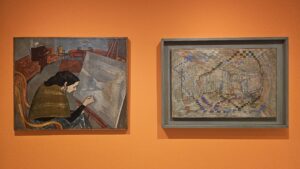Of all 23 delightful tales written and illustrated by Beatrix Potter in her life, The Tailor of Gloucester is one of my favourites and it takes place around Christmas. It was finished by Christmas 1901, to be given as a Christmas present to the daughter of Potter’s former governess.
Ian Holm played the tailor in a live-action TV adaptation in 1989, but the real surprise is that it features Jude Law in a very early role as the Mayor’s stableboy.
The tale starts with a quote from Richard III and tells the story of a tailor who’s finishing a luxurious waistcoat for the Mayor of Gloucester.
One bitter cold day near Christmas-time the tailor began to make a coat (a coat of cherry-coloured corded silk embroidered with pansies and roses) and a cream-coloured satin waistcoat (trimmed with gauze and green worsted chenille) for the Mayor of Gloucester.
The Tailor is working hard, a little too hard, maybe. One evening he’s too tired for chores and he tasks his cat Simpkin to go out and fetch food: the tailor gives Simpkin their last fourpence and he asks for a china pipkin, a penn’orth of bread, a penn’orth of milk, and a penn’orth of sausages. But, most importantly, he asks the cat to buy one penn’orth of cherry-coloured silk with the last penny of our fourpence. And he really means the last.
It turns out the coat is a really important one, as the Mayor of Gloucester is to be married on the morning of Christmas day.
While the cat is out, the tailor makes his acquaintance with a family of well-dressed mice. Will these mice be of any help, when inevitably the cat returns home without the cherry-coloured silk that’s necessary to finish the Mayor’s jacket? As usual, you’ll have to read the tale.










No Comments